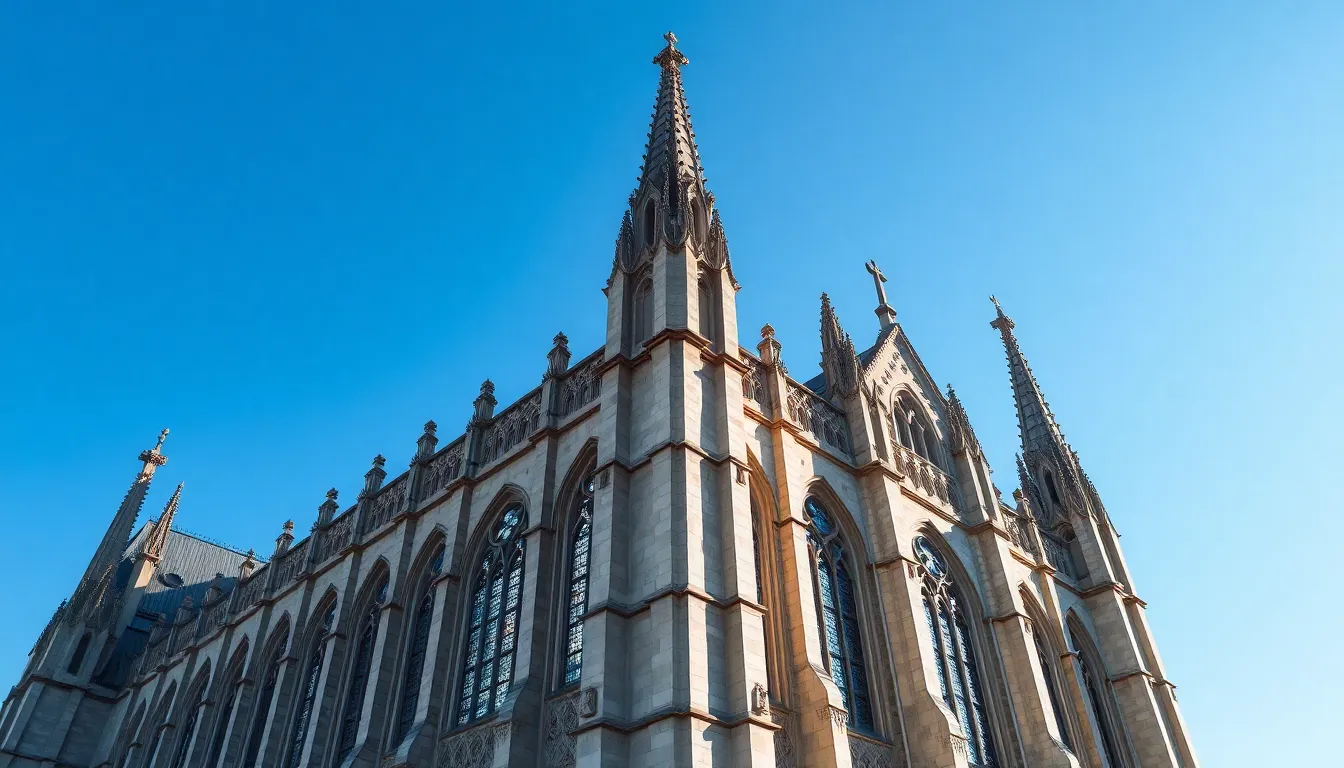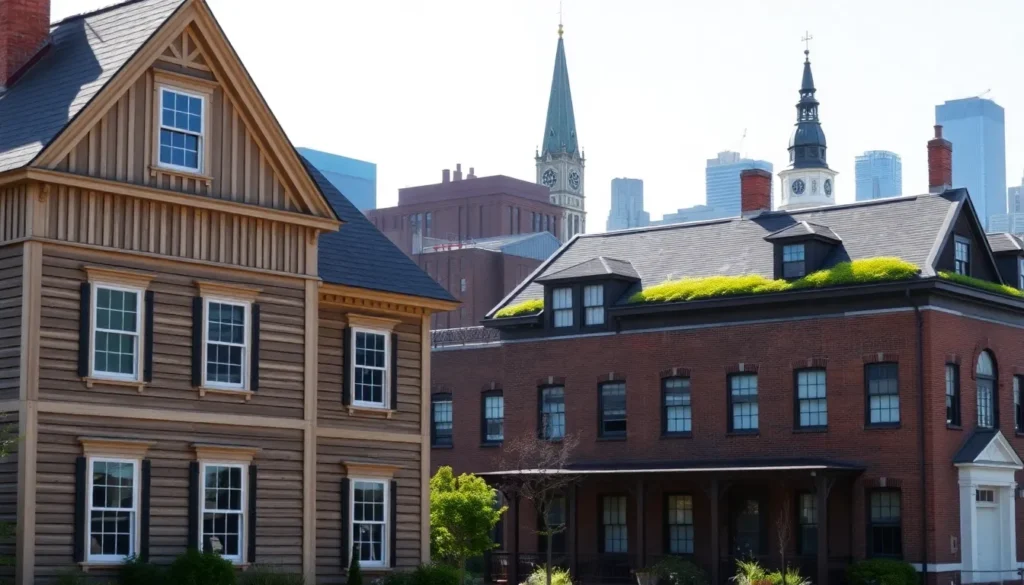Table of Contents
ToggleStep into a world where buildings seem to pierce the sky and gargoyles keep watch over the streets. Gothic architecture isn’t just a style; it’s a dramatic narrative etched in stone. With its soaring spires and intricate details, this architectural marvel has captivated hearts and sparked imaginations for centuries. Who wouldn’t want to stroll through a cathedral that looks like it jumped straight out of a medieval fairy tale?
From the majestic Notre-Dame to the awe-inspiring Chartres, these structures are a testament to human creativity and ambition. They blend beauty and function in a way that even the most seasoned architect would applaud. So grab your imaginary hard hat and get ready to dive into the enchanting world of Gothic architecture, where every arch tells a story and every shadow holds a secret.
Overview of Gothic Architecture
Gothic architecture emerged in the 12th century and flourished in Europe until the 16th century. This architectural style is notable for its innovative use of structural elements. One key feature includes the pointed arch, which allows for greater height and stability than previous styles.
Flying buttresses support walls, enabling the creation of large stained glass windows. These windows often portray biblical stories, immersing viewers in their narratives. Ribbed vaults enhance the ceiling structure, providing both decorative elements and functional support.
Noteworthy buildings like Notre-Dame de Paris and Chartres Cathedral exemplify Gothic architecture’s grandeur. Each structure showcases meticulous craftsmanship through intricate carvings and detailed sculptures. Towering spires dominate city skylines, drawing the eye upward toward the heavens.
Gothic architecture emphasizes light and space, transforming interiors into vast, luminous areas. Iconic elements such as gargoyles serve practical and aesthetic purposes, channeling rainwater while adding an air of mystery.
This architectural style not only reflects religious devotion but also the social and political aspirations of its time. Communities rallied around these monumental projects, which often took decades or even centuries to complete. The construction of cathedrals brought together artisans, laborers, and architects, fostering a sense of unity and purpose.
As visitors explore these historic sites, they encounter a blend of artistry and engineering that continues to inspire admiration. Understanding the principles of Gothic architecture deepens appreciation for its enduring legacy in the built environment.
Key Characteristics of Gothic Architecture

Gothic architecture features distinct elements that define its style and functionality. Understanding these characteristics provides insight into its enduring appeal.
Pointed Arches
Pointed arches serve as a defining feature of Gothic architecture. These arches allow for increased height and a more dramatic visual impact compared to round arches. They redistribute weight more efficiently, enabling builders to reach greater elevations. The design also creates a sense of upward movement, guiding the eye towards the heavens. Structures like cathedrals benefit from this innovation, enhancing their intimidating presence. Builders utilized pointed arches to enhance both structural stability and aesthetic value, shaping the overall Gothic experience.
Ribbed Vaults
Ribbed vaults exemplify the engineering prowess within Gothic architecture. These vaults consist of intersecting ribbed frameworks that support the ceiling. By distributing weight more evenly, they allow for the incorporation of larger windows, which flood interiors with natural light. Decorated with intricate patterns, ribbed vaults become more than just functional; they also contribute to the beauty of the space. This feature enhances acoustics, important for the sound of choirs and ceremonies. Notably, ribbed vaults mark a significant evolution in architectural techniques, influencing future styles.
Flying Buttresses
Flying buttresses offer essential structural support in Gothic architecture. These external braces transfer the weight of the vaulted ceilings to the ground, freeing walls for expansive windows. By allowing taller buildings with thinner walls, flying buttresses contribute to the overall elegance of these structures. They often feature decorative designs, serving both aesthetic and functional purposes. Commonly seen in famous cathedrals, they support large stained glass windows that narrate biblical tales. Through their innovative design, flying buttresses became a hallmark, transforming the architectural landscape of Europe during the Gothic period.
Historical Context of Gothic Architecture
Gothic architecture represents a significant shift in building design, emerging during a transformative period in European history.
Origins in the 12th Century
Gothic architecture originated in the 12th century, evolving from Romanesque styles. This transition marked a response to religious and social changes in Europe. Architects aimed for grandeur, leading to the development of crucial elements like the pointed arch. Builders sought to create taller, more expansive structures, which resulted in innovative techniques to support larger roofs and walls. The first notable examples include the Basilica of Saint Denis near Paris, which showcased these new design principles. As trends spread across France, powerful cathedrals began to dominate urban landscapes, reflecting the aspirations of communities.
Influential Regions and Movements
Regions across Europe significantly influenced Gothic architecture’s development. France served as the epicenter, with iconic structures manifesting in cities like Paris and Chartres. The styles traversed borders, inspiring movements in England, Germany, and Italy. Each region adapted the principles to local preferences and cultural contexts. Notable English cathedrals, such as Canterbury and York Minster, exhibited unique features, including distinct elongated windows and intricate stone masons’ work. In Germany, the blend of Gothic with regional styles produced striking variations. Italian interpretations included a focus on elaborate facades and classical details, merging Gothic elements with Renaissance ideals.
Notable Examples of Gothic Architecture
Gothic architecture features remarkable structures that exemplify its artistry and innovation. Key buildings include cathedrals, churches, castles, and palaces, each showcasing unique characteristics of this style.
Cathedrals and Churches
Cathedrals and churches dominate the Gothic landscape. Notre-Dame de Paris remains one of the most iconic examples, showcasing stunning flying buttresses and ornate stained glass windows. Chartres Cathedral stands out with its impressive labyrinth and twin spires, which symbolize the path to spiritual enlightenment. The Cologne Cathedral in Germany represents the pinnacle of Gothic design, famous for its towering spires and detailed sculptures. These structures not only reflect religious devotion but also embody the craftsmanship of their era, vividly narrating biblical stories through architecture.
Castles and Palaces
Castles and palaces also exhibit Gothic influences, incorporating grandeur and defense. The Château de Chambord in France merges Gothic and Renaissance styles, featuring distinctive rooflines with spires and elaborate chimneys. Neuschwanstein Castle in Germany captures romanticized Gothic elements, enchanting visitors with its fairy-tale appearance and picturesque setting. The Palace of Westminster in London showcases intricate facades and pointed arches, demonstrating the versatility of Gothic architecture in civic buildings. Such designs highlight both aesthetic appeal and functionality, bridging the divide between art and everyday use.
Influence on Modern Architecture
Gothic architecture profoundly shapes modern architectural design. Its structural innovations inspire contemporary architects to explore height and light in new ways. Techniques like the pointed arch and ribbed vault continue to be integrated into current structures, promoting both stability and aesthetic appeal.
Architects frequently draw from Gothic elements, emphasizing vertical lines and large windows. The use of flying buttresses in modern buildings provides both strength and an expansive feel, echoing the grace of medieval cathedrals. Noteworthy structures, such as the Saint Mary’s Cathedral in San Francisco, showcase these influences through their soaring ceilings and intricate designs.
Cities around the world also reflect Gothic principles in urban planning. Modern public spaces incorporate features that promote community engagement, emulating the collective spirit of Gothic projects. A combination of function and beauty characterizes many new buildings, similar to the designs of notable Gothic cathedrals.
Beyond aesthetics, the emphasis on light remains a key component of contemporary architecture. Architects utilize large glass facades to allow natural illumination, reminiscent of the stained glass windows found in Gothic structures. This strategy not only enhances the visual experience but also promotes energy efficiency.
Several modern examples exemplify this connection to Gothic roots. The Cathedral of Christ the Light in Oakland incorporates large windows and innovative design reminiscent of traditional Gothic architecture. Similarly, the Sydney Opera House seizes the opportunity to convey a sense of grandeur and elegance, inspired by the dramatic forms of Gothic cathedrals.
Continued interest in Gothic architecture ensures its influence resonates in contemporary design. The meticulous craftsmanship of Gothic-era builders instills a sense of pride among modern architects, who aim to honor that legacy through innovative yet respectful adaptations.
Gothic architecture stands as a testament to human creativity and ambition. Its intricate designs and innovative structures not only transformed skylines but also shaped cultural identities. Each cathedral and castle tells a story of the era’s aspirations and beliefs, inviting exploration and admiration.
As modern architects draw inspiration from these historical masterpieces, the essence of Gothic architecture remains alive in today’s designs. The marriage of beauty and functionality continues to resonate, ensuring that this architectural style will influence generations to come. The legacy of Gothic architecture is not just in its structures but in its ability to inspire awe and connect people to their history.


